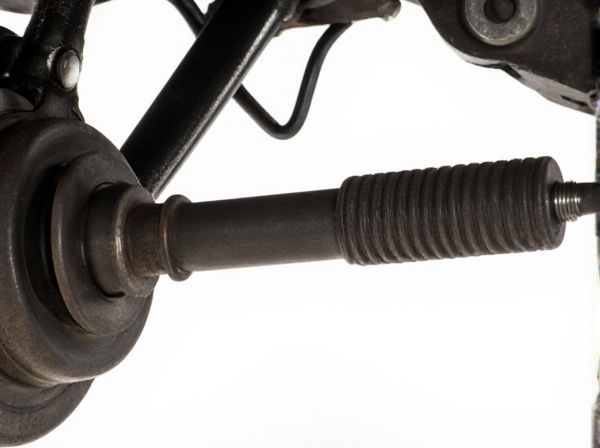
Photo illustration: Pitman Arm vs Idler Arm
The Pitman arm converts the steering wheel's rotational motion into linear motion to move the steering linkage, while the idler arm supports the opposite side of the steering linkage to maintain proper alignment and stability. You can identify wear in the Pitman arm by loose or sloppy steering, whereas a worn idler arm often causes uneven tire wear and steering wander. Both components are essential for precise steering control and vehicle safety.
Table of Comparison
| Feature | Pitman Arm | Idler Arm |
|---|---|---|
| Function | Converts steering box motion to steering linkage | Supports steering linkage, maintains alignment |
| Location | Connected to steering gear output shaft | Mounted on the vehicle frame opposite the Pitman Arm |
| Role in Steering | Primary driver of steering movement | Stabilizes and balances movement |
| Wear and Maintenance | Subject to wear; requires regular inspection | Wear affects steering play; check bushing condition |
| Common Issues | Loose or worn joints causing steering play | Worn bushings causing steering instability |
| Component Type | Lever arm with ball joint | Pivot arm with bushings |
Introduction to Pitman Arm and Idler Arm
The Pitman arm is a crucial steering component connecting the steering box to the steering linkage, translating rotational motion into linear movement for directional control. The idler arm supports the steering linkage on the passenger side, maintaining alignment and stability to ensure smooth steering operation. Both parts work in tandem to provide responsive and accurate vehicle steering.
Understanding the Steering System
The Pitman arm connects the steering box to the steering linkage, translating rotational motion from the steering shaft into linear movement to steer the wheels. The idler arm supports the steering linkage on the opposite side of the Pitman arm, maintaining proper alignment and reducing play in the steering system. Together, these arms ensure precise and stable steering control by coordinating the movement of the front wheels.
What Is a Pitman Arm?
A Pitman arm is a critical component in a vehicle's steering system that connects the steering box to the center link or drag link, converting rotational motion from the steering gearbox into linear motion that turns the wheels. It translates driver input into precise steering movements, crucial for maintaining accurate vehicle control and alignment. Unlike the idler arm, which supports the steering linkage on the opposite side, the Pitman arm directly transfers steering force from the gearbox to the linkage.
What Is an Idler Arm?
An idler arm is a key component in a vehicle's steering system that supports the steering linkage and helps maintain proper alignment between the pitman arm and the steering knuckle. It acts as a pivot point on the passenger side, allowing smooth and stable movement of the steering linkage while reducing play and wear. Unlike the pitman arm, which connects directly to the steering gearbox, the idler arm serves as a stabilizing support to ensure precise steering control.
Key Differences Between Pitman Arm and Idler Arm
The Pitman arm connects the steering box to the steering linkage, converting rotational motion into linear motion to steer the wheels, while the idler arm supports the steering linkage on the passenger side, maintaining alignment and stability. The Pitman arm is a moving component directly involved in steering input, whereas the idler arm acts as a pivot point, ensuring proper geometry of the steering system. Their distinct functions are crucial for accurate and responsive steering performance in vehicles.
Functions and Roles in the Steering Mechanism
The Pitman arm converts the rotational motion from the steering gearbox into linear motion, directly controlling the movement of the steering linkage. The idler arm supports the steering linkage on the passenger side, maintaining proper alignment and stability while allowing the Pitman arm to move smoothly. Together, these components ensure precise and responsive steering control by balancing movement and support within the steering mechanism.
Signs of Pitman Arm and Idler Arm Failure
Signs of Pitman arm failure include excessive steering play, vibrations in the steering wheel, and uneven tire wear due to misalignment. Idler arm failure is characterized by clunking noises during turns, steering wheel wander, and difficulty maintaining a straight driving line. Both components affect steering stability and require prompt inspection to prevent unsafe driving conditions.
Maintenance and Replacement Tips
Regular inspection of the Pitman Arm and Idler Arm is crucial for maintaining steering system integrity, with attention to wear signs such as looseness or excessive play indicating the need for replacement. Use grease fittings to lubricate both arms periodically, preventing premature failure caused by friction and corrosion. Replacement should match OEM specifications to ensure proper alignment and avoid steering issues, and it is advisable to inspect associated tie rods and ball joints during service.
Pitman Arm vs Idler Arm: Common FAQs
Pitman Arm vs Idler Arm: Common FAQs often revolve around their distinct roles in steering systems, where the Pitman Arm converts the steering wheel's motion into the steering linkage movement and the Idler Arm supports the steering linkage on the opposite side to ensure stable alignment. Common questions include how to identify failure symptoms, with Pitman Arm issues causing loose steering or erratic response, and Idler Arm wear resulting in uneven tire wear or clunking noises. Regular inspection and timely replacement of these components are critical for safe, precise vehicle handling.
Conclusion: Choosing the Right Component for Your Vehicle
Selecting the right component between a Pitman arm and an idler arm depends on your vehicle's steering system requirements and overall suspension design. The Pitman arm directly transfers steering input from the steering box to the center link, essential for precise control in many rear-wheel-drive vehicles. The idler arm supports the center link on the opposite side, maintaining alignment and reducing wear, making it crucial for balanced steering stability in many truck and SUV applications.
 caratoz.com
caratoz.com